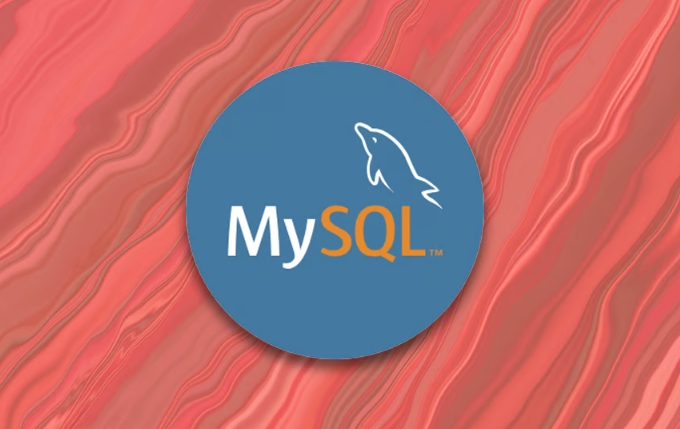Implementing SSL/TLS encryption for MySQL connections
Jul 02, 2025 pm 04:02 PMThe MySQL connection enables SSL/TLS encryption to prevent data from being eavesdropped or tampered during transmission and ensures the security of communication between the client and the server. 1. First, confirm whether the MySQL version supports SSL, and check it through the SHOW VARIABLES LIKE 'have_ssl' command. If NO is returned, you need to install the OpenSSL component or use a distribution that supports SSL; 2. Prepare the CA certificate, server certificate and private key files, you can build your own CA and generate related files. The test environment can use a self-signed certificate. It is recommended to use a trusted CA to issue it in the production environment; 3. Specify the ssl-ca, ssl-cert and ssl-key paths in the MySQL configuration file, and restart the MySQL service to take effect. Verify whether it is enabled successfully through SHOW STATUS LIKE 'Ssl_cipher'; 4. Add REQUIRE when creating a user SSL forces SSL connection. When the client connects, SSL parameters such as --ssl-ca and --ssl-mode must be specified. Different tools need to manually enable SSL options; in addition, you need to pay attention to the certificate file permissions, path correctness and whether the client really enables SSL mode to ensure that the entire connection process is encrypted and reliable.

MySQL connection enables SSL/TLS encryption, mainly to prevent data from being eavesdropped or tampered during transmission. This step is critical if you are managing database services or are responsible for secure communication between applications and databases. Simply put, after SSL/TLS is enabled, all communications between the client and the MySQL server will be encrypted, and it is difficult to interpret the content even if someone intercepts the traffic.

Here are some practical suggestions to help you complete the configuration smoothly.

1. Ensure that MySQL supports SSL/TLS
Not all MySQL versions have SSL enabled by default. First, you need to confirm whether your MySQL version supports SSL connections. You can view it through the following command:
SHOW VARIABLES LIKE 'have_ssl';
If the return value is YES , it means that MySQL already has SSL support; if it is DISABLED or NO , you may need to install or configure SSL-related components, such as OpenSSL, and recompile MySQL or use a distribution that supports SSL (such as Percona Server or MariaDB).

2. Prepare SSL certificate file
You need to prepare three core files:
- CA certificate (ca.pem)
- Server Certificate (server-cert.pem)
- Server private key (server-key.pem)
You can generate these files yourself or buy them from a trusted CA institution. Self-signed certificates are suitable for testing environments, but production environments recommend using formal certificates.
The basic steps for generating a self-signed certificate are as follows (openSSL is required):
Generate CA private key and certificate:
openssl genrsa 2048 > ca-key.pem openssl req -new -x509 -nodes -days 365 -key ca-key.pem -out ca.pem
Generate server private key and certificate request:
openssl req -newkey rsa:2048 -days 365 -nodes -keyout server-key.pem -out server-req.pem openssl x509 -req -in server-req.pem -days 365 -CA ca.pem -CAkey ca-key.pem -CAcreateserial -out server-cert.pem
After the generation is completed, put these three files in the location specified in the MySQL configuration, usually a directory like /etc/mysql/ssl/ .
3. Configure MySQL to enable SSL
Modify MySQL's configuration file (usually my.cnf or my.ini ) and add the following content in the [mysqld] section:
[mysqld] ssl-ca=/etc/mysql/ssl/ca.pem ssl-cert=/etc/mysql/ssl/server-cert.pem ssl-key=/etc/mysql/ssl/server-key.pem
Then restart the MySQL service to make the configuration take effect:
sudo systemctl restart mysql
You can use the following SQL statement to verify that SSL is loaded correctly:
SHOW STATUS LIKE 'Ssl_cipher';
If you see an output value (non-empty), it means that SSL has been enabled successfully.
4. Force the client to use SSL connection
It is not enough to enable SSL, and it is also necessary to make sure that the client is indeed using encryption when connecting. You can add a forced SSL option when creating a user:
GRANT USAGE ON *.* TO 'secure_user'@'%' REQUIRE SSL; FLUSH PRIVILEGES;
This way, the user must connect via SSL, otherwise access will be denied.
In addition, SSL parameters must be specified when connecting to the client. For example, use the command line to connect:
mysql -u secure_user -p --host=your.mysql.server --ssl-ca=/path/to/ca.pem --ssl-mode=VERIFY_IDENTITY
Different client tools (such as MySQL Workbench, Navicat, etc.) also have corresponding SSL settings. Remember to check "Use SSL" and import the CA certificate.
Basically that's it. Although the process is not complicated, there are several things that are easy to ignore: First, the permissions issue, ensuring that the MySQL process can read the certificate file; Second, whether the certificate path is correctly configured; Third, whether the client has truly enabled SSL mode. As long as these points are noticed, SSL/TLS can operate stably.
The above is the detailed content of Implementing SSL/TLS encryption for MySQL connections. For more information, please follow other related articles on the PHP Chinese website!

Hot AI Tools

Undress AI Tool
Undress images for free

Undresser.AI Undress
AI-powered app for creating realistic nude photos

AI Clothes Remover
Online AI tool for removing clothes from photos.

Clothoff.io
AI clothes remover

Video Face Swap
Swap faces in any video effortlessly with our completely free AI face swap tool!

Hot Article

Hot Tools

Notepad++7.3.1
Easy-to-use and free code editor

SublimeText3 Chinese version
Chinese version, very easy to use

Zend Studio 13.0.1
Powerful PHP integrated development environment

Dreamweaver CS6
Visual web development tools

SublimeText3 Mac version
God-level code editing software (SublimeText3)

Hot Topics
 What is a typical process for MySQL master failover?
Jun 19, 2025 am 01:06 AM
What is a typical process for MySQL master failover?
Jun 19, 2025 am 01:06 AM
MySQL main library failover mainly includes four steps. 1. Fault detection: Regularly check the main library process, connection status and simple query to determine whether it is downtime, set up a retry mechanism to avoid misjudgment, and can use tools such as MHA, Orchestrator or Keepalived to assist in detection; 2. Select the new main library: select the most suitable slave library to replace it according to the data synchronization progress (Seconds_Behind_Master), binlog data integrity, network delay and load conditions, and perform data compensation or manual intervention if necessary; 3. Switch topology: Point other slave libraries to the new master library, execute RESETMASTER or enable GTID, update the VIP, DNS or proxy configuration to
 How to connect to a MySQL database using the command line?
Jun 19, 2025 am 01:05 AM
How to connect to a MySQL database using the command line?
Jun 19, 2025 am 01:05 AM
The steps to connect to the MySQL database are as follows: 1. Use the basic command format mysql-u username-p-h host address to connect, enter the username and password to log in; 2. If you need to directly enter the specified database, you can add the database name after the command, such as mysql-uroot-pmyproject; 3. If the port is not the default 3306, you need to add the -P parameter to specify the port number, such as mysql-uroot-p-h192.168.1.100-P3307; In addition, if you encounter a password error, you can re-enter it. If the connection fails, check the network, firewall or permission settings. If the client is missing, you can install mysql-client on Linux through the package manager. Master these commands
 Why do indexes improve MySQL query speed?
Jun 19, 2025 am 01:05 AM
Why do indexes improve MySQL query speed?
Jun 19, 2025 am 01:05 AM
IndexesinMySQLimprovequeryspeedbyenablingfasterdataretrieval.1.Theyreducedatascanned,allowingMySQLtoquicklylocaterelevantrowsinWHEREorORDERBYclauses,especiallyimportantforlargeorfrequentlyqueriedtables.2.Theyspeedupjoinsandsorting,makingJOINoperation
 What are the transaction isolation levels in MySQL, and which is the default?
Jun 23, 2025 pm 03:05 PM
What are the transaction isolation levels in MySQL, and which is the default?
Jun 23, 2025 pm 03:05 PM
MySQL's default transaction isolation level is RepeatableRead, which prevents dirty reads and non-repeatable reads through MVCC and gap locks, and avoids phantom reading in most cases; other major levels include read uncommitted (ReadUncommitted), allowing dirty reads but the fastest performance, 1. Read Committed (ReadCommitted) ensures that the submitted data is read but may encounter non-repeatable reads and phantom readings, 2. RepeatableRead default level ensures that multiple reads within the transaction are consistent, 3. Serialization (Serializable) the highest level, prevents other transactions from modifying data through locks, ensuring data integrity but sacrificing performance;
 How to safely purge old MySQL binlog files?
Jun 19, 2025 am 01:01 AM
How to safely purge old MySQL binlog files?
Jun 19, 2025 am 01:01 AM
To clean MySQL binlog files, you should use the PURGEBINARYLOGS command or set the automatic expiration time, and files cannot be deleted directly. 1. Use the PURGE command to clean old logs by file name or time. Before execution, you need to confirm that the slave library no longer uses the relevant logs; 2. Check the current log status and slave library location through SHOWMASTERSTATUS and SHOWSLAVESTATUS to ensure the security of the cleaning range; 3. It is recommended to set the binlog_expire_logs_seconds parameter to achieve automatic cleaning, which is suitable for long-term operation environments; 4. Deleting files directly will cause serious problems such as master-slave synchronization failure and inconsistent log information, and must be avoided.
 How to add the MySQL bin directory to the system PATH
Jul 01, 2025 am 01:39 AM
How to add the MySQL bin directory to the system PATH
Jul 01, 2025 am 01:39 AM
To add MySQL's bin directory to the system PATH, it needs to be configured according to the different operating systems. 1. Windows system: Find the bin folder in the MySQL installation directory (the default path is usually C:\ProgramFiles\MySQL\MySQLServerX.X\bin), right-click "This Computer" → "Properties" → "Advanced System Settings" → "Environment Variables", select Path in "System Variables" and edit it, add the MySQLbin path, save it and restart the command prompt and enter mysql--version verification; 2.macOS and Linux systems: Bash users edit ~/.bashrc or ~/.bash_
 How to install MySQL on Windows 11
Jun 29, 2025 am 01:47 AM
How to install MySQL on Windows 11
Jun 29, 2025 am 01:47 AM
The key steps for installing MySQL on Windows 11 are as follows: 1. Download the correct version, select the Windows MSI installation package and ensure that the system is 64-bit; 2. Select the "Custom" mode during installation, add MySQLServer and set the appropriate installation path; 3. Run the configuration wizard, select the "ServerComputer" configuration type, set the root password, and select the automatic startup method; 4. After the test installation is successful, if the prompt command is unavailable, add the MySQL bin directory to the system PATH environment variable. Follow these steps to complete the installation and configuration smoothly.
 Resetting the root password for MySQL server
Jul 03, 2025 am 02:32 AM
Resetting the root password for MySQL server
Jul 03, 2025 am 02:32 AM
To reset the root password of MySQL, please follow the following steps: 1. Stop the MySQL server, use sudosystemctlstopmysql or sudosystemctlstopmysqld; 2. Start MySQL in --skip-grant-tables mode, execute sudomysqld-skip-grant-tables&; 3. Log in to MySQL and execute the corresponding SQL command to modify the password according to the version, such as FLUSHPRIVILEGES;ALTERUSER'root'@'localhost'IDENTIFIEDBY'your_new






